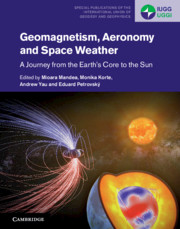Book contents
- Geomagnetism, Aeronomy and Space Weather
- Special Publications of the International Union of Geodesy and Geophysics Series
- Geomagnetism, Aeronomy and Space Weather
- Copyright page
- Contents
- Contributors
- Preface
- Part I Introduction
- 1 Objectives of Geomagnetic and Aeronomy Studies
- 2 Why Study the Geomagnetic Field?
- 3 Major Scientific Contributions of the International Association of Geomagnetism and Aeronomy (IAGA) during the Past 100 Years
- Part II Geomagnetic Field
- Part III Spatial and Temporal Variations of the Geomagnetic Field
- Part IV Space Weather
- Part V Magnetic Fields beyond the Earth and beyond Today
- Index
- References
1 - Objectives of Geomagnetic and Aeronomy Studies
from Part I - Introduction
Published online by Cambridge University Press: 25 October 2019
- Geomagnetism, Aeronomy and Space Weather
- Special Publications of the International Union of Geodesy and Geophysics Series
- Geomagnetism, Aeronomy and Space Weather
- Copyright page
- Contents
- Contributors
- Preface
- Part I Introduction
- 1 Objectives of Geomagnetic and Aeronomy Studies
- 2 Why Study the Geomagnetic Field?
- 3 Major Scientific Contributions of the International Association of Geomagnetism and Aeronomy (IAGA) during the Past 100 Years
- Part II Geomagnetic Field
- Part III Spatial and Temporal Variations of the Geomagnetic Field
- Part IV Space Weather
- Part V Magnetic Fields beyond the Earth and beyond Today
- Index
- References
Summary
The geomagnetic field’s domain extends from the Earth’s core, through the atmosphere, and into space, where it acts as a control on the flow of the solar wind around the Earth. It gives the ability to probe into structures, properties and processes wherever there is finite electrical conductivity, and magnetic and electric field observations provide key data for advancing understanding of many components of the Earth system. In addition, the record of geomagnetic field evolution ‘fossilised’ in magnetised rocks has provided influential evidence shaping our understanding of Earth’s history through much of geological time. Here, a brief account is given of how human curiosity has led from the discovery of magnetism and its application to navigation through the invention of the compass, to the diverse areas of modern-day scientific investigation where understanding the influence of the geomagnetic field is important in finding answers to forefront research questions. Despite recent technological innovations, the geomagnetic field has kept its usefulness for navigation, for example in hydrocarbons production, bringing economic benefits. The threat space weather events pose to technologies both on the ground and in near-Earth space is stimulating applied research, helping to manage the risk to systems on which modern societies rely.
Keywords
- Type
- Chapter
- Information
- Geomagnetism, Aeronomy and Space WeatherA Journey from the Earth's Core to the Sun, pp. 3 - 6Publisher: Cambridge University PressPrint publication year: 2019
References
- 1
- Cited by



